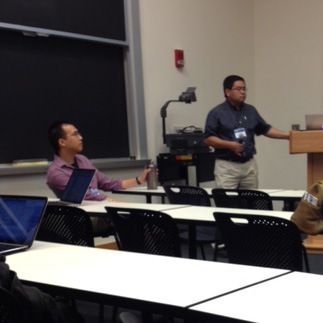At one of the afternoon breakout sessions during the Learning With MOOCs conference today, Jeff Merriman, Brandon Muramatsu and Cole Shaw spoke on ‘Tools to Enable the Design and Reuse of MOOC Materials’.
 The team of technologists and programmers from MIT’s Office of Digital Learning focused on mining the contents of a MOOC where one tends to find discrete elements that have potential to be used elsewhere.
The team of technologists and programmers from MIT’s Office of Digital Learning focused on mining the contents of a MOOC where one tends to find discrete elements that have potential to be used elsewhere.
Some of the questions that ensue from this are:
Merriman, Muramatsu and Shaw have been been developing a set of tools to help manage the granularity of learning activities available on MOOC platforms, such as edX.
They are focusing on four core areas of content:
Their motivation was to devising ways to- support content re-use, especially content that is being developed for edX courses at MIT?
 One of the areas they are exploring is the creation of an alternate authoring environment for edX, named Backstage Services. Backstage enables one to break up edX classes into bits and pieces. One can search classes, pull material from other edX classes, and add it to another class using drag-n-drop. Backstage is graphical authoring experience, amd also displays the underlying xml. This initiative is in its beta phase and has not yet been applied to live platforms.
One of the areas they are exploring is the creation of an alternate authoring environment for edX, named Backstage Services. Backstage enables one to break up edX classes into bits and pieces. One can search classes, pull material from other edX classes, and add it to another class using drag-n-drop. Backstage is graphical authoring experience, amd also displays the underlying xml. This initiative is in its beta phase and has not yet been applied to live platforms.
The assessment service will be the first piece of integration that the team will be experimenting in the live site. They hope to generate a rich set of data around assessments.
Some Q & A highlights from the audience:
Q1: how do you deal with IP issues? If a professor develops content for one course, can it be adapted for another course?
A: Yes, we have a catalog structure (referred to as ‘banks’). One can give or not give access rights and manage access privileges for their content. One can also create a special catalog with separate granular access privileges separate.
Q2: When I use this content in a course, how is the content cited? How do I know where it came from? How does my audience understand who created it, how to attribute it?
A: We have copyright and licensing records that people can use, but the creator has to fill in the fields, we don’t require it. In open applications we will need to track ownership. We will need to know rights and copyright as we move into a more managed system. It’s important and necessary.
To learn more, access the team's slides here.
- Molly Ruggles